|
 Secure Site
Secure Site
|
 |
Archive for October, 2012
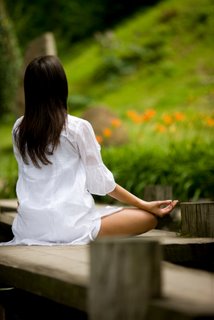 meditation New research shows that meditation can help you improve your ability to concentrate in two ways. First, it can make you better at focusing on something specific while ignoring distractions. Second, it can make you more capable of noticing what is happening around you, giving you a fuller perspective on the present moment.
Some of the most fascinating research on how meditation affects attention is being conducted by Antoine Lutz, PhD, an associate scientist at the Waisman Laboratory for Brain Imaging and Behavior at the University of Wisconsin at Madison, in collaboration with Richard Davidson and the Laboratory for Affective Neuroscience at the University of Wisconsin. Their work has shown that concentration meditation, in which the meditator focuses complete attention on one thing, such as counting the breath or gazing at an object, activates regions of the brain that are critical for controlling attention. This is true even among novice meditators who receive only brief training. Experienced meditators show even stronger activation in these regions. This you would expect, if meditation trains the brain to pay attention. But extremely experienced meditators (who have more than 44,000 hours of meditation practice) show less activation in these regions, even though their performance on attention tasks is better. The explanation for this, in Lutz’s view, is that the meditation training can eventually help reduce the effort it takes to focus your attention. “This would be consistent with traditional accounts of progress in meditation practice. Sustaining focus becomes effortless,” Lutz says. This suggests that people can immediately enhance concentration by learning a simple meditation technique, and that practice creates even more progress.
adapted from Yoga Journal by Kelly McGonigal
Although meditation can be done in almost any context, practitioners usually employ a quiet, tranquil space, a meditation cushion or bench, and some kind of timing device to time the meditation session. Ideally, the more these accoutrements can be integrated the better. Thus, it is conducive to a satisfying meditation practice to have a timer or clock that is tranquil and beautiful. Using a kitchen timer or beeper watch is less than ideal. And it was with these considerations in mind that we designed our digital Zen Alarm Clock and practice timer. This unique “Zen Clock” features a long-resonating acoustic chime that brings the meditation session to a gradual close, preserving the environment of stillness while also acting as an effective time signal.
 Zen Timer for Yoga and Meditation Now & Zen – The Zen Meditation Timer & Clock Store
1638 Pearl Street
Boulder, CO 80302
(800) 779-6383
Posted in yoga, Yoga Timer, Yoga Timers by Now & Zen
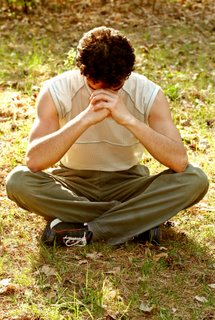 use your chime timer to practice breathing Fall is the season when the lungs, believed to harbor sadness and grief, are most vulnerable, according to Chinese medicine. In response to cold, dry weather, they begin to constrict. To keep yours healthy and strong as cold and flu season approaches, Ni suggests this breathing exercise: Sit with your spine tall and your hands on your abdomen. Draw in a deep breath for a count of 10, expanding your abdomen and then filling your lungs. Exhale in reverse for another 10 count, squeezing out all the air you can. Set your Chime Timer by Now & Zen for 15 minutes and continue until the calming chime strikes.
adapted from Wholeliving.com, October 2010
The Zen Alarm Clock is a consciousness-raising tool. No material object can actually raise your consciousness, but you can use information and devices such as this clock to stimulate your growth. The Zen Alarm Clock can effect your awareness in a variety of positive ways, all of which require your participation.
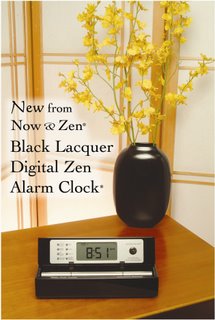 Chime Timers, time your wellness practice with a calming chimes
Now & Zen – The Zen Chime Timer Store
1638 Pearl Street
Boulder, CO 80302
Posted in intention, Meditation Timers, Meditation Tools, mindfulness practice, Well-being
 meditative tea ceremony Prepare for Tea During The Winter Season.
In one traditional Japanese tea ceremony, guests are met at the gate by their host and led silently through a garden to the tea room, signifying a departure from the everyday world and an entrance into a spiritual realm.
You probably don’t have a dedicated tea room, but you too can create a space in your afternoon for disconnecting from the day’s stresses, whether you’re at the office or at home. Here’s our simple step-by-step approach to creating your own personal tea ceremony.
Dedicate a Space
This can mean moving to another room, a favorite chair, or just to the other side of your desk — or simply clearing a space for tea on your table or work space. You might consider using a place mat or a tray to visually set your tea space apart from everything else.
Set the Stage
A tea ceremony is about atmosphere. Light a candle or play music to set the mood. If you’re in a busy office, just close your eyes and listen to your breath for a few minutes to switch gears and set the tone.
Select Your Tea.
Bring some intention to your choice. What are you in the mood for? A mild, grassy green? A refreshing peppermint? A rich, vibrant oolong or black tea? As Confucius said, “Let your palate be your guide.”
Use Your Favorite Accoutrements
The personal objects you use for tea making will help make this practice your own. Whether it’s a pretty mug, an iron teapot, or a favorite infuser, using something special for your tea ritual inspires a ceremonial feel.
“The Zen Alarm Clock & Chime Timer’, uses soothing acoustic chimes that signal it’s time – gently and gradually.
Rather than an artificial recorded sound played through a speaker, the Zen Clock features an alloy chime bar similar to a wind chime. When the clock’s alarm is triggered, its chime produces a long-resonating, beautiful acoustic tone reminiscent of a temple gong.
adapted from Body + Sou Magazine, 2005
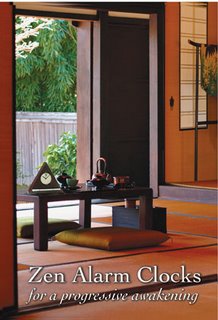 Tea Ceremonies for Relaxation, tea timers with chime by Now & Zen Now & Zen – Chime Timers and Alarm Clocks
1638 Pearl Street
Boulder, CO 80302
(800) 779-6383
Posted in intention, Meditation Timers, Tea Ceremony, Zen Timers
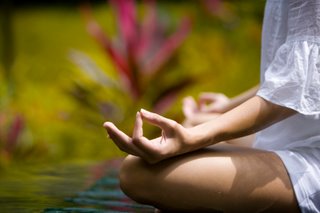 meditation Stress is the immune system’s worst enemy. Whether you’re dealing with a brief bout of craziness like Christmas shopping, or a longer-lasting stressor like divorce, your body’s ability to fight germs is compromised by physical and mental tension. Meditation can help. One study found that people who attended an eight-week mindfulness meditation class (a three-hour class once a week, plus daily meditation for an hour) ended up with stronger immune systems than those people who didn’t meditate. Researchers believe that the meditation-induced relaxation boosted the group’s immunity. Over time, high levels of stress hormones dampen the immune system, says Timothy McCall, MD, Yoga Journal’s medical editor and author of Yoga as Medicine. “So it makes sense that by practicing mindfulness-based stress reduction, your immune system benefits.” Research shows that even 10 minutes of daily meditation reduces the physical symptoms of stress. (To learn meditation techniques, go to yogajournal.com, click on “Practice,” and then choose “Meditation.”)
“The Zen Alarm Clock & Chime Timer’, uses soothing acoustic chimes that signal it’s time – gently and gradually.
Rather than an artificial recorded sound played through a speaker, the Zen Clock features an alloy chime bar similar to a wind chime. When the clock’s alarm is triggered, its chime produces a long-resonating, beautiful acoustic tone reminiscent of a temple gong.
adapted from Yoga Journal by Catherine Guthrie
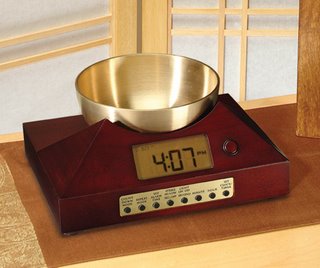 Zen Timepiece with Brass Singing Bowl, a Meditation timer to Calm your Mind Now & Zen – Zen Chime Meditation Timers and Clocks
1638 Pearl Street
Boulder, CO 80302
(800) 779-6383
Posted in Well-being, yoga, Yoga Timer, Yoga Timers by Now & Zen, zen
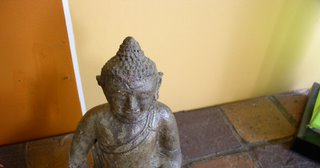 Use your Zen Timer to pause each day In the midst of a pressure-packed day, it’s tempting to grit your teeth and push through. Why not take a breather? “When you pause after an exhale, before drawing in your next breath, you create a moment that allows you to let go of whatever transpired before,” says Roman Szpond, founder and owner of Inner Strength Studios in Watertown, Massachusetts. This temporary respite prevents stress from snowballing, interrupts the tendency to take shallow breaths, and raises self-awareness. “Once you see how you’re contributing to your own tension,” he says, “you can make adjustments.” Best of all, this inconspicuous technique works anywhere — at the dentist, at your desk, even in the midst of a tense conversation. So go ahead. Hit “pause.”
Try It Right Now
1. Lengthen
Sit or stand, with both feet flat on the floor. Imagine the top of your head extending toward the ceiling.
What it does
Creates space in the spine and torso, allowing your lungs to expand fully.
2. Inhale
Take a deep, full breath: Picture your abdomen filling with air from the bottom of your belly, and your lungs filling to the top of your chest. Set your Zen Timer for 5 minutes and continue with this breathing exercise.
What it does
Brings oxygen into your cells, restoring and energizing your whole body.
3. Exhale
Release the breath in reverse order, from the top of the lungs to the lowest part of the belly. At the same time, mentally let go of anything that’s bothering you.
What it does
“The exhale is detoxifying,” Szpond explains. “It’s like a sigh, releasing as much emotional energy as it does air.”
4. Pause
When you reach the “bottom” of your exhale, rest for a beat before you inhale (without tightening or holding your breath); repeat. “Think of it as simply allowing your breathing mechanism to relax for a moment,” says Szpond.
What it does
Creates a moment of stillness that helps your mind slow down and your body relax.
Use our unique “Zen Clock” which functions as a Yoga & Meditation Timer. It features a long-resonating acoustic chime that brings your meditation or yoga session to a gradual close, preserving the environment of stillness while also acting as an effective time signal. Our Yoga Timer & Clock can be programmed to chime at the end of the meditation or yoga session or periodically throughout the session as a kind of sonic yantra. The beauty and functionality of the Zen Clock/Timer makes it a meditation tool that can actually help you “make time” for meditation in your life. Bring yourself back to balance.
adapted from Body + Soul, March 2008
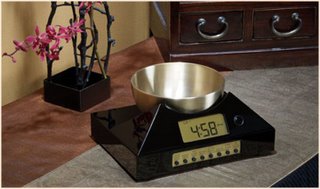 Zen Timepiece, tibetan singing bowl timer and clock
Now & Zen – The Zen Timer Store
1638 Pearl Street
Boulder, CO 80302
(800) 779-6383
Posted in intention
 Brain Aid -- Meditation and Yoga
Science has proven that meditating actually restructures your brain and can train it to concentrate, feel greater compassion, cope with stress, and more.Read the latest research and put it into practice.Yoga citta vritti nirodhah. Yoga is the ending of disturbances of the mind. (Yoga Sutra, I.2)
Nothing is quite as satisfying as a yoga practice that’s filled with movement. Whether you prefer an intense and sweaty vinyasa practice, a gentle but deliberate Viniyoga practice, or something in between, all systems of hatha yoga provide a contented afterglow for the same reason: You sync your movement with your breath. When you do, your mind stops its obsessive churning and begins to slow down. Your attention turns from your endless to-do list toward the rhythm of your breath, and you feel more peaceful than you did before you began your practice.
For many of us, accessing that same settled, contented state is more difficult to do in meditation. It’s not easy to watch the mind reveal its worries, its self-criticism, or its old memories. Meditation requires patience and—even more challenging for most Westerners—time. So, why would you put yourself through the struggle?
Quite simply, meditation can profoundly alter your experience of life. Thousands of years ago the sage Patanjali, who compiled the Yoga Sutra, and the Buddha both promised that meditation could eliminate the suffering caused by an untamed mind. They taught their students to cultivate focused attention, compassion, and joy. And they believed that it was possible to change one’s mental powers and emotional patterns by regularly experiencing meditative states. Those are hefty promises.
But these days, you don’t have to take their word for it. Western scien-tists are testing the wisdom of the masters, using new technology that allows researchers to study how meditation in-fluences the brain.
 Meditating to the rescue
The current findings are exciting enough to encourage even the most resistant yogis to sit down on the cushion: They suggest that meditation—even in small doses—can profoundly influence your experience of the world by remodeling the physical structure of your brain.
Although meditation can be done in almost any context, practitioners usually employ a quiet, tranquil space, a meditation cushion or bench, and some kind of timing device to time the meditation session. Ideally, the more these accoutrements can be integrated the better. Thus, it is conducive to a satisfying meditation practice to have a timer or clock that is tranquil and beautiful. Using a kitchen timer or beeper watch is less than ideal. And it was with these considerations in mind that we designed our digital Zen Alarm Clock and practice timer. This unique “Zen Clock” features a long-resonating acoustic chime that brings the meditation session to a gradual close, preserving the environment of stillness while also acting as an effective time signal.
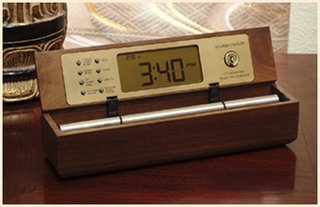 Digital Zen Alarm Clock - A Meditation Timer and Alarm Clock adapted from Yoga Journal, by Kelly McGonigal
Now & Zen’s Meditation Timer Store
1638 Pearl Street
Boulder, CO 80302
(800) 779-6383
Posted in Chime Alarm Clocks, intention, Meditation Timers, Meditation Tools, Well-being, zen, Zen Timers
 how to teach yoga to kids If you’re planning to teach yoga to kids, there are a few general things to know that will enhance your experience. The greatest challenge with children is to hold their attention long enough to teach them the benefits of yoga: stillness, balance, flexibility, focus, peace, grace, connection, health, and well-being. Luckily, most children love to talk, and they love to move—both of which can happen in yoga. Children will jump at the chance to assume the role of animals, trees, flowers, warriors. Your role is to step back and allow them to bark in the dog pose, hiss in the cobra, and meow in cat stretch. They can also recite the ABCs or 123s as they are holding poses. Sound is a great release for children and adds an auditory dimension to the physical experience of yoga.
Children need to discover the world on their own. Telling them to think harder, do it better, or be a certain way because it’s good for them is not the optimal way. Instead, provide a loving, responsive, creative environment for them to uncover their own truths. As they perform the various animal and nature asanas, engage their minds to deepen their awareness. When they’re snakes (Bhujangasana), invite them to really imagine that they’re just a long spine with no arms and legs. Could you still run or climb a tree? In Tree Pose (Vrksasana), ask them to imagine being a giant oak, with roots growing out of the bottoms of their feet. Could you stay in the same position for 100 years? If you were to be chopped down, would that be OK? Would it hurt?
When they stretch like a dog, balance like a flamingo, breathe like a bunny, or stand strong and tall like a tree, they are making a connection between the macrocosm of their environment and the microcosm of their bodies. The importance of reverence for all life and the principle of interdependence becomes apparent. Children begin to understand that we are all made of the same “stuff.” We’re just in different forms.
Think of yourself as a facilitator—the term we use in the YogaKids program—rather than a teacher. Guide your children while simultaneously opening your heart and letting them guide you. They’ll no doubt invite you into a boundless world of wonder and exploration. If you choose to join them, the teaching/learning process will be continually reciprocal and provide an opportunity for everyone to create, express themselves, and grow together.
Use our unique “Zen Clock” which functions as a Yoga Timer. It features a long-resonating acoustic chime that brings your meditation or yoga session to a gradual close, preserving the environment of stillness while also acting as an effective time signal. Our Yoga Timer & Clock can be programmed to chime at the end of the meditation or yoga session or periodically throughout the session as a kind of sonic yantra. The beauty and functionality of the Zen Clock/Timer makes it a meditation tool that can actually help you “make time” for meditation in your life. Bring yourself back to balance.
adapted from Yoga Journal by Marsha Wenig
 yoga timer - tools for teaching yoga to kids Now & Zen – The Yoga Clock & Timer Store
1638 Pearl Street
Boulder, CO 80302
(800) 779-6383
Posted in intention, mindfulness practice, Walking Meditation, Well-being, yoga, Yoga Timer, Yoga Timers by Now & Zen
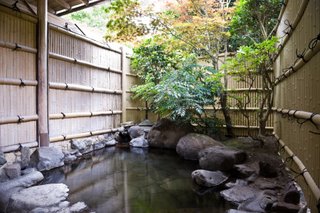 sacred soaking Water, a powerful and restorative element in exquisite rituals throughout the ages, finds itself front and center in most spiritual rites of passage. Many cultures consider water essential for both physical and spiritual cleansing, and millions continue to embark upon quests to holy rivers and healing springs, drawn to water equally for its soothing properties as well as its promise of purification.
Perhaps this draw to water feels so instinctual because our brains, blood, and even our muscles are composed mainly of water. When we submerge ourselves, we return, in essence, to a deep, primordial connection with the world around us. Through the simple act of bathing, we can celebrate this ancient relationship between water and life. With minimal effort, a daily bath becomes a meditative and mystical experience, helping us to connect with our own inner wisdom.
“Mankind has used water to restore the physical, mental, and emotional body since ancient times,” says Barbara Close, founder of Naturopathica Holistic Health and author of Pure Skin: Organic Beauty Basics (Chronicle Books, 2005). “From the beginning, the use of water as a conduit or healing agent has existed for both its physical and emotional healing properties.”
Long before holy wells began to draw pilgrims or the custom of “taking the waters” became popular at lavish bathing halls in Europe, ancient cultures in Asia, Indonesia, and Mesoamerica had their own elaborate bathing rituals, which often involved the use of steam and ceremonial sound. Both the Aztec Temazcal and Mayan Zumbul-che wove in musical elements to signify the start of the cleansing ritual. In parts of today’s world, including Indonesia, Southeast Asia, and island nations of the Pacific, cultures still associate wells, springs, and rivers with the Goddess, the feminine principle, and birth. Women add flower petals to ritual water as an extra flourish, imbuing their bath with the powerful spiritual energy associated with native plants. In the Javanese bath ritual that prepares brides for their wedding night, attendants first scrub and exfoliate the skin with turmeric and then rub it with yogurt to soften it. A luxurious bath with flowers and petals follows, and only then is the bride deemed purity incarnate.
 water “Each and every one of us, and every fragment of life on our planet, has an inner and outer relationship with water,” says Nadine Epstein, author (with Rosita Arvigo) of Spiritual Bathing: Healing Rituals and Traditions From Around the World (Celestial Arts, 2003). “The first living cells were formed in the salt bath of the sea, and I love imagining the blood that flows within us as a kind of internal sea. We are beings of water on a planet that is distinguished by its possession of water, the rushing waters that the early Jews called ‘living waters’ or mayyim hayyim.”
Ritual and renewal
You can connect with the healing energy of water by preparing your own spiritual bath at home. First order of business: Decide what you want to manifest in your life. The prospects run the gamut from the desire to release personal sadness or frustration to the hope of reducing global suffering. Next, establish the mood. The usual suspects, candles and incense, have traditionally been part of many prayer settings, but let your imagination run wild. Create an even richer ambiance by including specific music, scents, symbols, and images that resonate with your concept of the divine.
“Personally, I love singing and chanting on the surface of the water, watching the ripples of my breath, and soaking up the sounds in the air,” says Epstein. “I’ve always been fascinated by sound waves and how they travel through solids, gases, and liquids. As a little girl, I remember my father, a physicist, mapping the trajectory of sound waves through crystals. The symmetries of these waves were and are a beautiful thing to behold. It all boils down to connecting with what the Maya call ch’ulel, the Chinese call chi, the Hindus call prana. Nearly every culture has a name for the subtle energies or vibrations that exist within us and beyond.”
Ultimately, only the reverence with which we enter the water matters. If we are receptive enough, our immersions can gradually wring a sea change upon our spirit, teaching us that we can learn as much from floating as we can from standing on firm ground.
Although meditation can be done in almost any context, practitioners usually employ a quiet, tranquil space, a meditation cushion or bench, and some kind of timing device to time the meditation session. Ideally, the more these accoutrements can be integrated the better. Thus, it is conducive to a satisfying meditation practice to have a timer or clock that is tranquil and beautiful. Using a kitchen timer or beeper watch is less than ideal. And it was with these considerations in mind that we designed our digital Zen Alarm Clock and practice timer. This unique “Zen Clock” features a long-resonating acoustic chime that brings the meditation session to a gradual close, preserving the environment of stillness while also acting as an effective time signal.
 Portable Zen Timer with Chime by Now & Zen, Inc. adapted from Natural Solutions Magazine, March 2007 by Debra Bokur
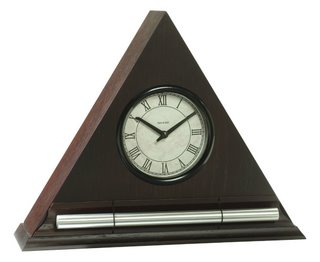 Natural Sound Alarm Clock with Chime Now & Zen’s Portable Meditation
Timer Store
1638 Pearl Street
Boulder, CO 80302
(800) 779-6383
Posted in Hot Springs, intention, Meditation Timers, Meditation Tools, mindfulness practice, Well-being
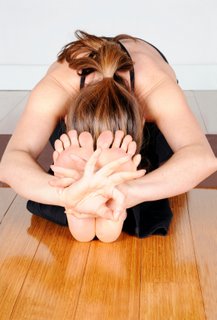 yoga forward bend Everyday stress can throw your entire system off kilter; your muscles tighten, your heart races, and your stomach starts acting up — again. A simple seated forward bend can activate a reserve of sustaining energy that, according to Chinese medicine, rests between the kidneys.
Everyday stress can throw your entire system off kilter; your muscles tighten, your heart races, and your stomach starts acting up — again. A simple seated forward bend can activate a reserve of sustaining energy that, according to Chinese medicine, rests between the kidneys. “It calms the nervous system, gets the organs fully functioning, and clears up obstructions in the kidneys and adrenal glands,” explains Daniel Max, nutrition counselor, shiatsu practitioner, and yoga instructor with Max Sense of Self in Watertown, Massachusetts. Get your qi back in no time with this quick stretch.
What It Does
Calms the mind; relieves stress; stretches the spine, shoulders, hamstrings, and back; stimulates the kidneys and adrenal glands; improves digestion; and reduces fatigue.
How to Do It
1. Sit with your legs extended straight in front of you, feet parallel with toes pointing up. Press the back of your legs into the floor.
2. Inhale deeply and lift through the upper body. With your spine straight and shoulders back, pull the navel in slightly toward the spine, creating space in the abdomen. Exhale, release, and lean forward, bending from the hip, not the waist.
3. Fold forward only as far as you can (keep your knees bent if that’s more comfortable). With each inhalation, lift and lengthen the front torso slightly; if you feel able to go further, release a little more fully into the bend on an exhale. Try not to crunch; maintain length through the spine.
4. Hold for a few breaths, allowing your body to open up. Direct your breath toward the kidneys, breathing deep into the lower back. Then inhale and sit up slowly, lifting your torso away from the thighs until your back is straight. Repeat 2 to 3 times. Set your Zen Timer for 20 minutes and continue until the chime sounds.
Use our unique “Zen Clock” which functions as a Yoga Timer. It features a long-resonating acoustic chime that brings your meditation or yoga session to a gradual close, preserving the environment of stillness while also acting as an effective time signal. Our Yoga Timer & Clock can be programmed to chime at the end of the meditation or yoga session or periodically throughout the session as a kind of sonic yantra. The beauty and functionality of the Zen Clock/Timer makes it a meditation tool that can actually help you “make time” for meditation in your life. Bring yourself back to balance.
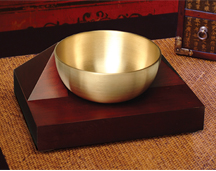 The Only Singing Bowl Yoga Timer and Alarm Clock adapted from Body + Soul Magazine, April 2008
Now & Zen’s Singing Bowl Yoga Timer Store
1638 Pearl Street
Boulder, CO 80302
(800) 779-6383
(800) 779-6383
Posted in intention, yoga, Yoga Timer, Yoga Timers by Now & Zen
 Feng Shui Tips If insomnia is a problem, don’t overlook the decor of your bedroom. Indeed, the legendary healer Hazel Parcells (1889-1996) once helped a sleepless client by insisting that she totally redo the room she slept in. “It had been decorated for years in a jungle motif,” says Joseph Dispenza, author of Live Better Longer: The Parcells 7-Step Plan for Health and Longevity (HarperCollins, 1997). “Imitation zebra skin sheets and drapes, wall hangings of monkeys in trees, and all of it set against a background of tropical colors of red, orange, and bright green. ‘There’s your problem,’ said Dr. Parcells, ‘You’re trying to get some sleep while your bedroom is engaged in monkey business all night!'”
Ideally, your bedroom should be restful and not used for anything but sex and sleep. Banish all paperwork and the television to other rooms, keeping clutter to a minimum. “Keep on hand the things you need while in bed but put away everything else,” says Donna Stellhorn, the owner of Moonrise Books in Albuquerque, New Mexico, and an expert in feng shui techniques. “The simpler the better,” she adds.
If that still doesn’t work, consider these tips:
Furniture, plants, and other objects should never loom or hang over the bed; they can threaten your subconscious mind. Plants should also be alive and green, not dry (suggesting death or morbidity) or spiky (threatening).
As for the bed, place it so your head is either facing north or east—experts disagree on which is best—in a spot where you will not be startled if a family member enters. And don’t let junk accumulate under the bed. It can disturb the flow of chi (energy) and affect your sleep.
Color is important. “Best is pale pink, peach, or lavender if you are healthy, but pale green or blue if you’ve been ill or low in energy,” says Stellhorn. Avoid bright colors and busy patterns.
Dr. Parcells also recommended natural—not synthetic—sheets, blankets, and pillows, the right room temperature, good air circulation, and few mirrors, which create cacophonous visual images.
Rather than a loud, buzzing alarm, greet the morning with a Zen Clock with Chime, Tibetan Bowl Clock, chirping birds, relaxing music, an energizing mist of peppermint oil, or a light that brightens gradually to imitate the rising sun.
Boulder, Colorado—an innovative company has taken one of life’s most unpleasant experiences (being startled awake by your alarm clock early Monday morning), and transformed it into something to actually look forward to. “The Zen Alarm Clock,” uses soothing acoustic chimes that awaken users gently and gradually, making waking up a real pleasure.
What makes this gentle awakening experience so exquisite is the sound of the natural acoustic chime, which has been tuned to produce the same tones as the tuning forks used by musical therapists. According to the product’s inventor, Steve McIntosh, “once you experience this way of being gradually awakened with beautiful acoustic tones, no other alarm clock will ever do.”
adapted from Yoga Journal Magazine, by Sally Eauclaire Osborne
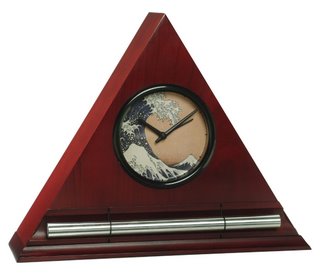 Chime Alarm Clock, a Natural Sound Alarm Clock Now & Zen – The Gentle, Chime Alarm Clock Store
1638 Pearl Street
Boulder, CO 80302
(800) 779-6383
Posted in Feng Shui, sleep, Sleep Habits, wake up alarm clock, Zen Alarm Clock, Zen Timers
« Previous Page — « Previous Entries
Next Entries » — Next Page »
|
|
|
|